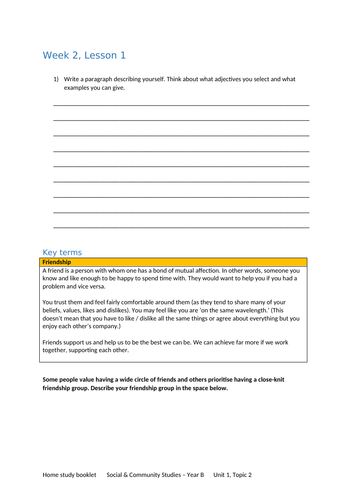


During this module students investigate their personality type and explore how people manage conflict. They apply conflict management strategies to real life contexts and make decisions about what strategies are most effective.
This is a work booklet pack which was designed for use during the 2020 COVID 19 pandemic. It would also be useful for students who are absent for medical / personal reasons. The content within this resource could be adapted into PowerPoints or worksheets for use in the classroom. This work pack contains three lessons worth of content.
Lesson 4 - students are to write a paragraph describing themselves. Students are introduced to the key term ‘friendship.’ They are asked to describe their friendship group in a few sentences. Students are to brainstorm the main reasons they fight with parents, siblings and friends. A metaphor (relationship bank accounts) is explained. Students list the deposits and withdrawals they make in three relationships of their choosing. Students read an explanation of some of the reasons why we fight with people we love: jealousy, one-way relationships, rejection, stress, disloyalty, revenge and peer pressure. Next to each they need to list examples of this from popular culture texts (e.g. movies, tv programs, celebrity feuds etc.)
Lesson 5 introduces students to the key terms ‘interpersonal’ and ‘intrapersonal intelligence.’ Following this, there is a passage about workplace behaviour which they need to read. There is a workplace scenario which students can read and respond to. Students then need to define aggressive, assertive and passive communication based on what they read in a handout / further research. There is a classifying activity for students to test their understanding of these terms. There is a paragraph writing activity about what students believe they should do if a work colleague does something that annoys them. Afterwards 3 workplace scenarios are listed. Students need to rate how stressful they would find that situation from 1-5 and how they would try to solve it.
Lesson 6 introduces students to the key term ‘self-concept.’ This is followed by an explanation of 5 different ways you could describe yourself. Afterwards, ‘self-esteem’ is defined along with terms optimism and pessimism. Two things that influence our self-esteem are noted. Students are to summarise what they have learned in this lesson. Afterwards they read information about ‘characteristics of low self esteem’ and how this can affect your quality of life. Some causes of low self esteem are explained as well as some tips for how to build one’s self esteem and who you could go to for help. The lesson concludes with a poster making activity (tips for improving self-esteem).
Part of a set of resources created for a senior Social & Community studies class in Australia (QCAA syllabus). The other resources are also available in my store - lrigb4. Designed for use in 70 minute lessons.
Something went wrong, please try again later.
This resource hasn't been reviewed yet
To ensure quality for our reviews, only customers who have purchased this resource can review it
Report this resourceto let us know if it violates our terms and conditions.
Our customer service team will review your report and will be in touch.
